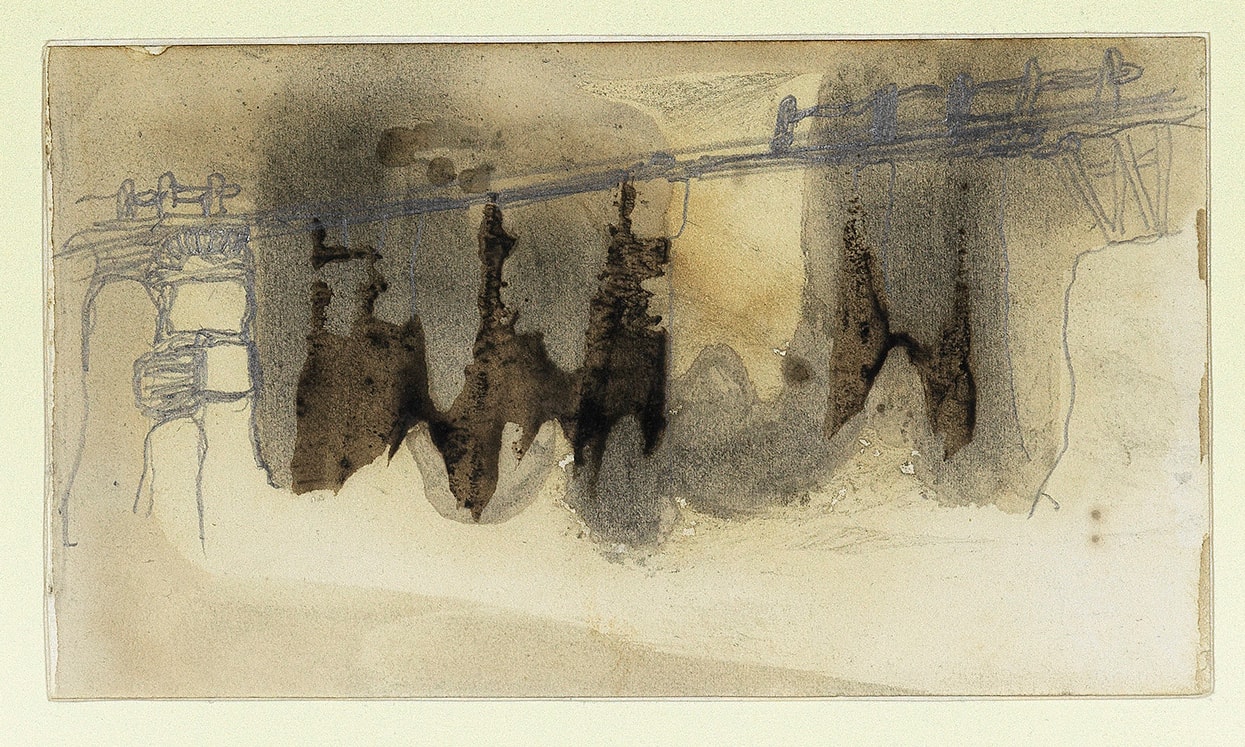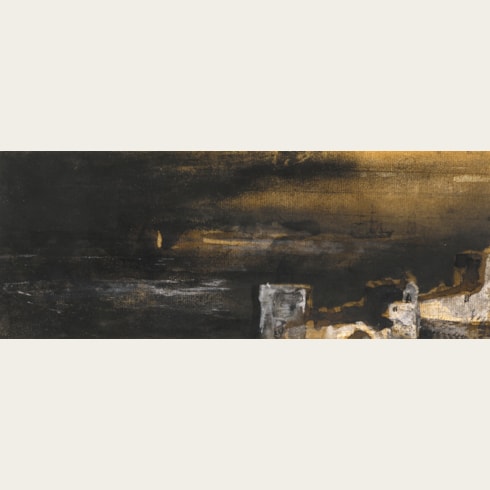Victor HUGO
(Besançon 1802 - Paris 1885)
Landscape with a Bridge, Guernsey
Sold
Pencil, brown ink, brown and grey wash, on laid paper from a sketchbook.
86 x 147 mm. (3 3/8 x 5 3/4 in.)
ACQUIRED BY THE STAATLICHE KUNSTHALLE, KARLSRUHE.
86 x 147 mm. (3 3/8 x 5 3/4 in.)
ACQUIRED BY THE STAATLICHE KUNSTHALLE, KARLSRUHE.
The present sheet was once part of a small pocket sketchbook of sixty-one pages, used by Victor Hugo between the 17th of June and the end of August or beginning of September 1856, during his fifteen-year period of exile in Guernsey. Of British manufacture, the sketchbook measured approximately 9 x 15 cm. and was dated and inscribed by Hugo on the inside front cover: ‘17 juin 1856 / (pris mon premier bain a Guernesey, a Fermain-bay, le vendredi / 27 juin 1856)’ together with a list of dates, including ‘21 juillet ma fête’, referring to his saint’s name day.
Since his arrival in Guernsey in 1855, Hugo had adopted the practice of carrying with him two types of small notebooks, or carnets. The first was a carnet de comptes, used mainly for accounts and household affairs, and was akin to a diary. The other type of notebook was mainly used by Hugo for drawings and sketches, as well as for jotting down bits of verse, quotations and poetry, and it is from this sort of carnet that the present sheet derives. The pages of this small sketchbook were comprised of landscape sketches, marine subjects, taches, automatic drawings of fantastical heads and creatures, lace impressions and rubbings, as well as some scenes at Hauteville House in Guernsey, the home which Hugo had purchased in May 1856.
Several of the pages in this 1856 Guernsey sketchbook contain drawings that are the result of experiments with taches, or inkblots, wherein the artist allowed his imagination free rein with whatever form the inkblot took. As Florian Rodari has noted, ‘Either he allowed the tache to expand by itself, modified only by the quantity of water, the quality of the paper and the obstacles it encountered in the course of its haphazard journey; or he guided it deliberately, steering it along paths opened up by chance more or less intentionally in the direction of recognizable forms or suggestive scenes...Most of the manipulations to which Hugo subjected the hazards of the tache resulted in landscapes or figures. Excess water caused the taches to expand, suggesting new solutions, new ways forward for the eye. This is what the artist liked; he would oversee the different possibilities.’ To these inkblots, Hugo would then add lines in pen or pencil, further developing the compositional idea created by the serendipitous flow of ink wash.
In the case of the present sheet, the artist seems to have first applied ink to the sheet by rolling a cylindrical object coated with brown ink across the paper. The resulting jagged shapes appear to have suggested the piers of a stone bridge to the artist, who then enhanced the form of the structure with pencil and grey wash. While the bridge itself may have been the result of Hugo’s imaginative transposition of the visual effect of the tache, the overall composition may also have been inspired by the rugged coastline, wooden breakwaters and rock formations of Guernsey, which so often provided the artist with a variety of dramatic motifs for his drawings.
Four pages from the same 1856 Guernsey sketchbook as the present sheet are today in the collection of the Musée Victor Hugo in Villequier, while several others are in private collections.
Since his arrival in Guernsey in 1855, Hugo had adopted the practice of carrying with him two types of small notebooks, or carnets. The first was a carnet de comptes, used mainly for accounts and household affairs, and was akin to a diary. The other type of notebook was mainly used by Hugo for drawings and sketches, as well as for jotting down bits of verse, quotations and poetry, and it is from this sort of carnet that the present sheet derives. The pages of this small sketchbook were comprised of landscape sketches, marine subjects, taches, automatic drawings of fantastical heads and creatures, lace impressions and rubbings, as well as some scenes at Hauteville House in Guernsey, the home which Hugo had purchased in May 1856.
Several of the pages in this 1856 Guernsey sketchbook contain drawings that are the result of experiments with taches, or inkblots, wherein the artist allowed his imagination free rein with whatever form the inkblot took. As Florian Rodari has noted, ‘Either he allowed the tache to expand by itself, modified only by the quantity of water, the quality of the paper and the obstacles it encountered in the course of its haphazard journey; or he guided it deliberately, steering it along paths opened up by chance more or less intentionally in the direction of recognizable forms or suggestive scenes...Most of the manipulations to which Hugo subjected the hazards of the tache resulted in landscapes or figures. Excess water caused the taches to expand, suggesting new solutions, new ways forward for the eye. This is what the artist liked; he would oversee the different possibilities.’ To these inkblots, Hugo would then add lines in pen or pencil, further developing the compositional idea created by the serendipitous flow of ink wash.
In the case of the present sheet, the artist seems to have first applied ink to the sheet by rolling a cylindrical object coated with brown ink across the paper. The resulting jagged shapes appear to have suggested the piers of a stone bridge to the artist, who then enhanced the form of the structure with pencil and grey wash. While the bridge itself may have been the result of Hugo’s imaginative transposition of the visual effect of the tache, the overall composition may also have been inspired by the rugged coastline, wooden breakwaters and rock formations of Guernsey, which so often provided the artist with a variety of dramatic motifs for his drawings.
Four pages from the same 1856 Guernsey sketchbook as the present sheet are today in the collection of the Musée Victor Hugo in Villequier, while several others are in private collections.
The preeminent literary figure in 19th century France, Victor Hugo was also an accomplished and prolific draughtsman. He produced nearly three thousand drawings, the principal groups of which are today in the collections of the Bibliothèque Nationale and the Maison de Victor Hugo in Paris. He began to draw seriously around 1825, but relatively little of this early work survives and it was not until some twenty years later that he was to develop his distinctive personal idiom. Hugo seems to have been most productive as a draughtsman during periods when he was writing less, as for example in 1850. Conversely, there are very few drawings from the period between 1852 and 1853, when he was engaged on a spell of intense literary activity. His drawings achieved a height of expression during the years of his political exile from France on the Channel Islands of Jersey, where he and his family lived from 1852 to 1855, and Guernsey, where he settled in 1855 and remained until 1870. Although he often gave drawings as presents to friends and colleagues, and allowed several sheets to be reproduced as engravings, the act of drawing for Hugo remained a largely private occupation. In the last ten years of his life, he drew much less, a decline mirrored in his literary output.
As a draughtsman, Hugo relied primarily on brown or black ink and wash, applied with a fluidity and transparency that allowed for remarkable tonal and atmospheric effects. His idiosyncratic working methods have been described by his son Charles Hugo: ‘Once paper, pen and ink-well have been brought to the table, Victor Hugo sits down and without making a preliminary sketch, without any apparent preconception, sets about drawing with an extraordinarily sure hand not the landscape as a whole but any old detail. He will begin his forest with the branch of a tree, his town with a gable, his gable with a weather vane, and, little by little, the entire composition will emerge from the blank paper with the precision and clarity of a photographic negative subjected to the chemical preparation that brings out the picture. That done, the draftsman will ask for a cup and will finish off his landscape with a light shower of black coffee. The result is an unexpected and powerful drawing that is often strange, always personal, and recalls the etchings of Rembrandt and Piranesi.’
Hugo also experimented with different techniques and media, including inkblots (taches), folded paper, stencilled cut-outs, gold leaf and impressions taken from various objects, including leaves and lace.
Provenance
Part of a sketchbook used by Victor Hugo in Guernsey in 1856
Private collection, France
Anonymous sale, Paris, Hôtel Drouot, 25 November 1992, lot 9
Galerie Jean-François Aittouarès, Paris
The album broken up in the 1990s and the present sheet acquired in 2001 by Jan Krugier and Marie-Anne Poniatowski, Geneva.
Literature
Venice, Galleria d’Arte Moderna Ca’ Pesaro, Victor Hugo pittore, 1993, p.220, under no.33 - F.25, illustrated p.130 (entry by Marie-Laure Prévost); Marie-Laure Prévost, “caos en el pincel...” Victor Hugo dibujos, exhibition catalogue, Madrid, 2000, pp.383-384, no.167, illustrated p.220 (as Paisaje de Guernesey); Marie-Laure Prévost, du chaos dans le pinceau...Victor Hugo dessins, exhibition catalogue, Paris, 2000-2001, p.381, no.167, illustrated p.220 (as Paysage guernesiais); Raphael Rosenberg and Max Hollein, ed., Turner Hugo Moreau: Entdeckung der Abstraktion, exhibition catalogue, Frankfurt, 2007-2008, no.125; Felix Krämer, ed., Dark Romanticism: From Goya to Max Ernst, exhibition catalogue, Frankfurt, 2012-2013, no.59, illustrated p.118; Gerhard Kehlenbeck, Victor Hugo: Visions of a Poet-Draughtsman, Hamburg, 2015, unpaginated, no.3.
Exhibition
Paris, Galerie Aittouares, Victor Hugo dessins, 1993, no.2; Venice, Galleria d’Arte Moderna Ca’ Pesaro, Victor Hugo pittore, 1993, no.33; Madrid, Museo Thyssen-Bornemisza, “caos en el pincel...” Victor Hugo dibujos, 2000, no.167; Paris, Maison de Victor Hugo, du chaos dans le pinceau...Victor Hugo dessins, 2000-2001, no.167; Frankfurt, Schirn Kunsthalle, Turner Hugo Moreau: Entdeckung der Abstraktion, 2007-2008, no.125; Frankfurt, Städel Museum, Dark Romanticism: From Goya to Max Ernst, 2012-2013, no.59; Paris, Musée d’Orsay, L’ange du bizarre: Le romantisme noir de Goya à Max Ernst, 2013, no.47.








